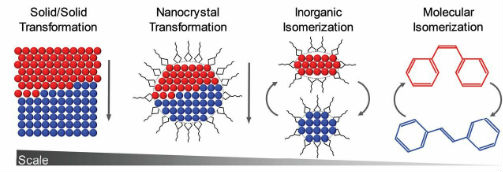|
NOVIDADES
Three years ago, when Richard Robinson, associate professor of materials science and engineering, was on sabbatical at Hebrew University in Israel, he asked a graduate student to send him some nanoparticles of a specific size. “When they got to me, I measured them with the spectrometer and I said, ‘Wait, you sent me the smaller particles instead of the bigger ones.’ And he said, ‘No, I sent you the bigger ones,’” recalls Robinson, of his conversation with his advisee Curtis Williamson, a doctoral student in chemical and biomolecular engineering. “We realized they must have changed while they were in flight. And that unleashed a cascade of questions and experiments that led us to this new finding.” They deduced that the particles had transformed during their trip from Ithaca to Jerusalem. This realization led to the discovery of inorganic isomerization, in which inorganic materials are able switch between discrete states almost instantaneously – faster than the speed of sound. The finding bridges the gap between what’s known about phase changes in organic molecules, such as those that make eyesight possible, and in bulk materials, like the transition of graphite into diamonds. Their find was surprising because it implied that inorganic materials could transform like organic molecules, said Robinson, co-author of the paper on these findings in Science ("Chemically Reversible Isomerization of Inorganic Clusters".  Isomerization is well established in small organic molecules (e.g., the cis-to-trans transformation of azobenzene), whereas bulk inorganic solids exhibit phase transformations. Although small in size, nanocrystals follow bulk-like behavior in their solid-solid transformations. At even smaller length scales, inorganic clusters isomerize with molecular- and inorganic solid–like characteristics. Red and blue indicate two different structures. Credit: Science
Williamson is the paper’s first author. Senior authors are Robinson; Tobias Hanrath, associate professor at the Smith School of Chemical and Biomolecular Engineering; and Uri Banin, professor of chemistry at Hebrew University. Douglas Nevers, Ph.D. ’18, Andrew Nelson, doctoral student in materials science and engineering, and Ido Hadar of Hebrew University also contributed. “We bridged the two worlds between big materials that change more slowly, and small, organic materials that can flip back and forth coherently, between two states,” Robinson said. “It’s surprising that we saw an instantaneous transformation from one state to another in an inorganic material, and it’s surprising that it is initiated with a simple surface reaction.” Isomerization – the transformation of a molecule into another molecule with the same atoms, just in a different arrangement – is common in nature. Often it’s sparked by the addition of energy, as when light causes a molecule in the retina to switch, enabling vision; or how olive oil, when heated too high, isomerizes into the unhealthy form known as a trans-fat. Bulk materials such as graphite can also change phases, but they require a lot more energy than at the molecular level and the change occurs more gradually, with the change spreading across the substance rather than an instantaneous transformation. In the past, larger nanoparticles were found to change phases in a way that was closer to how bulk materials change than to molecules. But when the Cornell team looked at even smaller clusters of atoms at the Cornell High Energy Synchrotron Source (CHESS), they observed the quick change between discrete states for the first time. “We now finally see that there’s a new regime where you can coherently flip from one state to another instantaneously,” Hanrath said. “If you make them small enough, the inorganic materials can flip back and forth very easily. It’s a revelation.” Robinson said the researchers would not have been able to precisely determine atoms’ positions without CHESS, where they performed total-scattering experiments in which they examined all the X-ray scatterings of the cluster, enabling them to pinpoint the locations of the atoms. They were also aided by a new technique they developed to create magic-sized clusters – so-called because they have the “perfect” number of atoms and no more individual atoms can be added, making them extremely stable. “We were able to come up with a very pure magic-sized cluster,” Robinson said. “Because of that, when it reacts with the alcohol or water you see a very pure transformation” from one discrete state to another. Though further research is needed, possible future applications include using these particles as switches in computing or as sensors, Robinson said. The discovery could also have uses relating to quantum computing or as a seed for the generation of larger nanoparticles. Cornell University. Posted: Feb 15, 2019. |
|||||||||||||||||||||||||